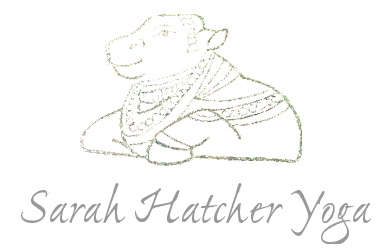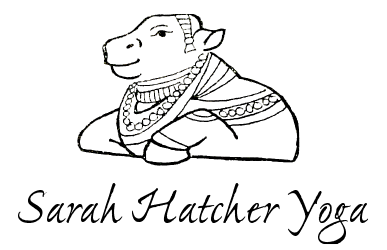Your living breathing Practice
If your practice was living being, how old would it live to be?
Are you a practitioner that has a ten-year practice burning at both ends? Are you firing away at it every day till it comes to a stop like an old car making noises when it is parked? Or are you smoothing out your practices daily, making them last a long time, and finishing each practice with ease and restoration?
I invite you to design your practice so that it is a living breathing well-oiled machine, that goes and goes for years to come. You see those old cars on the road whose owners have reinvented, painted, cared for, and taken out with a bit of pride when they drive them? We want our practices to be like those adored cars as we age.
Your practice is a lifelong friend. Build the relationship with your practice that you would want to have till your last days. Your prāṇic relationship is worth the daily investment: notice how you feel when the marriage of breath and movement is symbiotic! Your majestic lungs thrive when you breathe fully, your skeletal system gets stronger with the natural lifting of your limbs - your digestive system stays rhythmic - and your eyes, ears and tastes mature. This reinvention of yourself each and every time you practice is a daily washing of yourself: you wash away those negative thoughts, add ojas and nourishment to your internal and external machine, you release tension, and the result is that your smile brightens.
How you oil your machine is your yoga - whether you take a day to explore one single asana, or you do the entire intermediate series - each time you step on the mat, you are doing so with the right intention that the daily dose of yoga that you are about to do - is the right amount for you.
“niḥśreyase jāṅgali-kāyamāne”
Look at these words chanted in your invocation to practice, most ashtanga yogis chant this at the beginning of the practice so it is an intention for a clear practice to be embarked upon. A basic translation is that “may I take refuge (niḥśreyase) in the teacher who heals any mental, emotional and spiritual problems that I may be suffering from" (jāṅjali-kāyamāne). This is the practice you are about to do - the practice is the teacher for you that day. Sure your teacher could be this as well, but it is the amount of yoga that you for that particular day which allows transformation to happen. This could be a lot or a little, it is what is needed for you for that practice.
Your āsana practice is a rejuvenation of life within you, it is a creative dance which has the freedom to explore and witness your self, that hidden self I keep writing about over and over again. It never gets old writing about puruṣa, the conscious self, because…well, I am curious! I appreciate taking the time to separate the thinking, acting, doing, and working field of my to explore that sweeter side of me, the quite side. This is the side that doesn’t do anything - it is just the observer, or even the passenger in the vehicle.
Beautiful flowers here in Ireland, heading into summer, there is no lack of expression!
It never gets old writing about the inner self that is hidden. It is our job as yogis to tune out the chattering of the mind and listen. As David Miliotis says, “Go into a dark closet and stay there. Listen. What do you hear?”
I’m coming to a place in my practice where I stop more often in the practice. Have a think. Sit still. Listen to my breath for a moment before moving into the next posture. Sometimes I even open my mouth and exhale with a smooth, even breath. This opening of the mouth and letting the cold air come in comes from those pregnant days of practice where I needed to maintain a coolness in the body. This simple moment of reflection brings me back to being more present. The same thing also happens when I keep my mouth closed, I focus on mūla bandha, have a glimpse into my spine, and then start the next posture with a quieter, smoother breath. Quieting the breath is key here - iron it out, listen more clearly, and to make it joyful, easy, and thoughtful.
Taking pauses, having a rest during your practice or even just having a sit for a moment is such a no-no in the ashtanga world.
Stop!? What? Keep going, don’t stop the meditative flow, right? Well I say no. There are interruptions everywhere - stop signs come, bends in the road, and navigation is required. If you are always moving at the same speed, head down and on a mission, sometimes you miss out on a new awareness that could only come when you find stillness. This could happen while you have settled into a posture, or by just resting for a few breaths in downward dog or childs pose, before doing the next posture. The best one of all - you could come to Samastiḥ.
Did you practice with me recently for the Full Vinyasa Primary Series? Get in touch if you’d like the recording, coming back to the top of the mat is the best way to take a pause and reflect before moving into the next pose. It is just like driving a vehicle: take the time to pull over, take that pit stop, and get back on the road with more focus. (I love me a good full vinyasa primary or intermediate - I try to do either one at least twice a month!)
Other times, I am moving fast like a dancer on the mat, each breath an invitation to move with full expression. Moving without thinking through each vinyasa and posture is a great meditative practice as well: what is really happening when you breathe to your fullest potential with each and every breath, and link it with movement - with no thinking? Meditation, concentration and absorption happens, sañyama. There are no stop signs, and all you do is go. You can still be very present, yogi, even if you end up being a little sloppier than usual. No stops. Now you wouldn't want to do this all the time - but once in a while this could be a great go-to when there is a lot on your mind.
Bright, slow, clear, rhythmic, bold, brave, courageous. And even…quiet. All of these could describe a practice any given day. Try this: on Monday do all of your standing postures to Baddha Konasana followed by full finishing poses. Do it without any interruptions. Then on Tuesday do all of your standing postures and then start your seated postures at Upaviṣtha Konasana - right back where you left off on Monday - finish the second half of primary but do it in Full Vinyasa form. Observe…did it take you same amount of time? Do you feel nourished after? Separate the series - one day do the first half and the other the second half. It isn’t a chore. You don’t have to do the full series every day - by breaking it up, and by doing it a different way, you may bring more ease to your practice week.
I have heard from my students and yogi friends that when they are most stressed, they often skip the practice. These are the times when it is better to do the bare minimum of practice rather than none at all. Just do some standing and some seated. The next day do some standing (the ones you didn’t do) and some seated (again, do the ones you didn't do the day before). Just do 30-45 minutes. You’ll see that by separating the practice over the course of the week you still get your full primary series. It just wasn’t done all in one day!
Practice when it is convenient for you, it doesn't matter when really, as long as you tend to it.
When I get the full eight hours of sleep, I am a better mother and better yogi. My eyes are clearer and I am more focused on the practice. Hard postures require clarity. Easy postures require maturity. They are all equally important. Tending to your loved ones with a calm mind and one that hasn’t been exhausted is just as important as your fancy practice. If you are getting up at zero-thirty to practice - continue to do it if this is the only time you have to practice…if you can put it in elsewhere in your day, do that instead. Drop the super early mornings, your co-workers, family members will thank you.
And you may even just kick your coffee habit for good.
Calvin and I walking at Glendalough - waterfalls and skipping stones in the river - our favourite!
Starting 25 June, I’ll be teaching online from my family’s home in Reno, Nevada - Pacific Coast time.
You can catch me three days a week - mornings at 6 am - for Prāṇāyama followed by Mysore on Mondays; Chanting class at 8 am Monday; Wednesday Led Intermediate at 6 am and on Friday, join me for led primary series at 6 am. Ireland and European yogis, this means these three days all start at 2 pm your time. This is so that Calvin, Dash and mommy spend a lot of time walking the Sierras. Classes will be recorded; just send me a message if you’d like to join.
Click on the practice calendar below for details:



